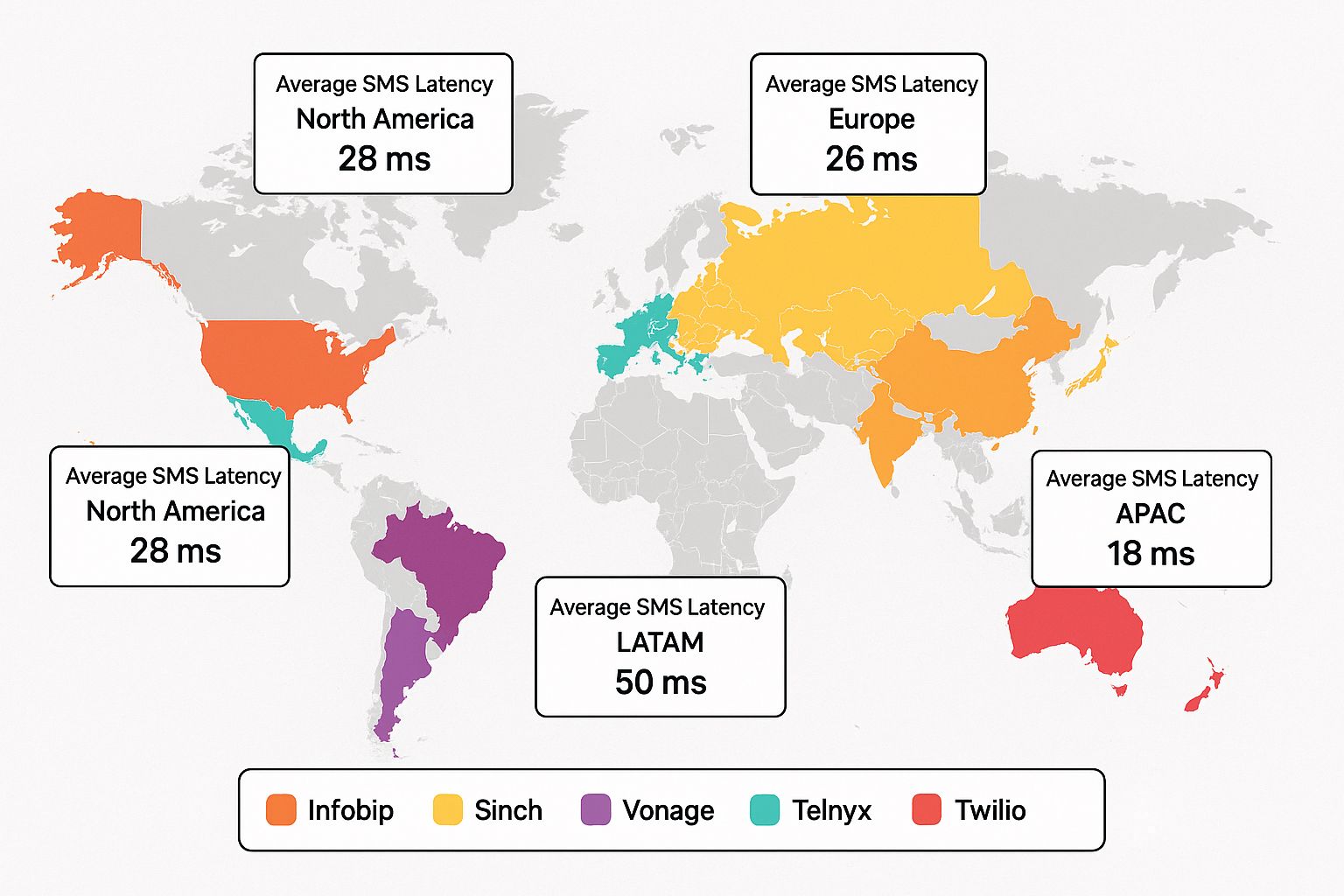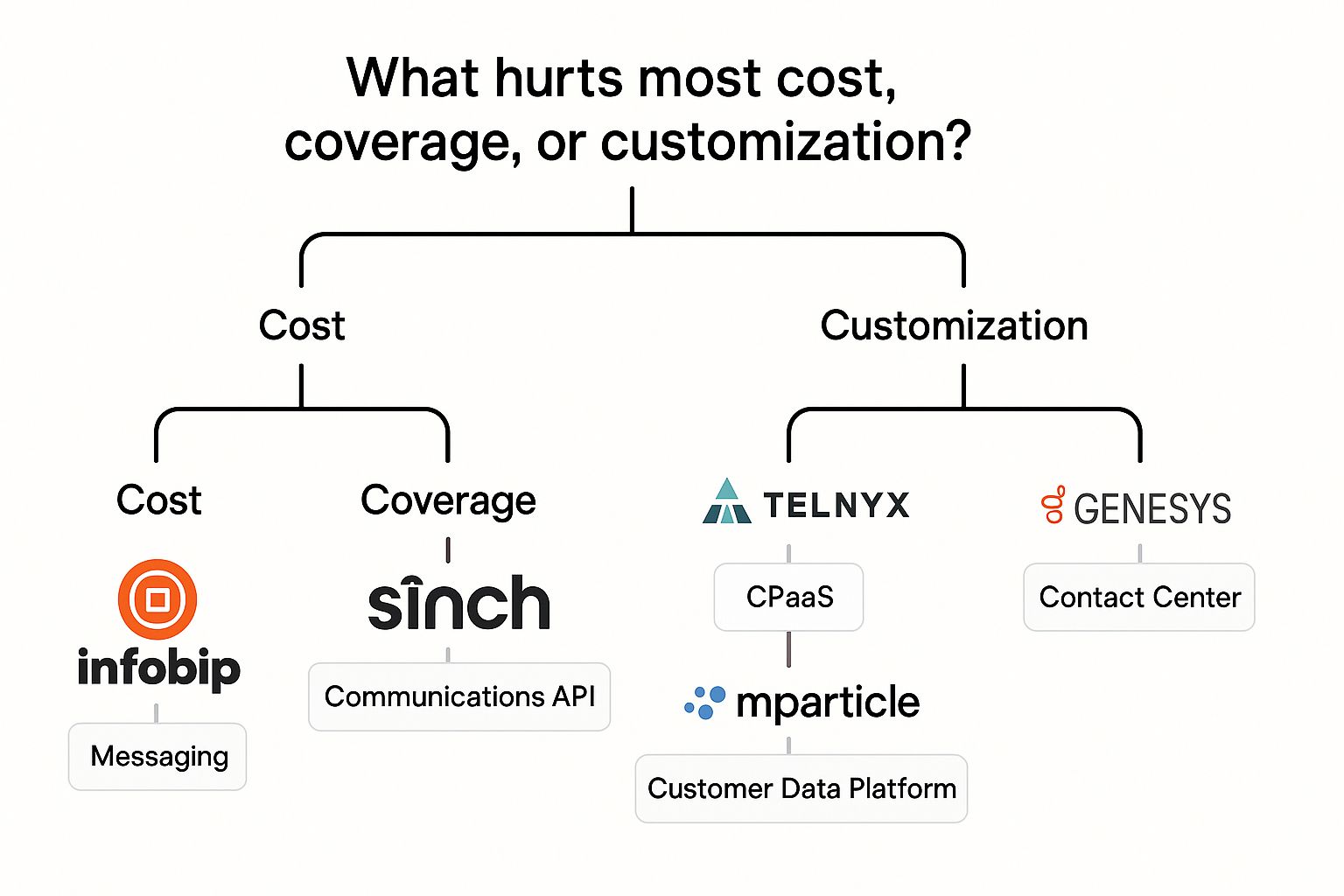Key Takeaway
- Don’t default to Twilio. Compare global suites (Infobip, Sinch, Vonage, Azure) and cost first players (Telnyx, Bandwidth, Plivo), plus product-specific rivals for Segment, Flex, Verify, and SendGrid.
- Pick by use case and true cost. Factor surcharges and support, then run a 48 – 72 hour canary test across regions to check delivery, latency, voice quality, and error rates.
- Keep Twilio if Studio/Functions/community speed you up; otherwise mix providers per channel (e.g., WhatsApp on one, voice/SMS on another) for price and reliability
Why are we even talking about ditching Twilio?
“I thought Twilio was the gold standard what changed?”
“Cost curves, regional deliverability, and product sprawl, that’s what.”
Twilio invented CPaaS, but 14 years later the playing field is crowded. Gartner’s latest buyer snapshot shows prospects short-listing Infobip, Sinch, Vonage, Azure Communication Services, and even regional up-starts like Bandwidth and Exotel when they evaluate Twilio’s Customer Engagement Platform.
Meanwhile, global demand for communication APIs is ballooning from $30 billion in 2025 to $48 billion by 2029, according to Juniper Research. Rising volume magnifies every cent you pay for SMS or voice, so finance teams are suddenly inside the dev stand - up asking, “Can we shave 30 percent off OTP sends?”
Add product creep Segment CDP, Flex contact center, Verify OTP, SendGrid email and you discover that “Twilio competitors” means different things to different teams. Let’s map each one, minus the sales jargon.
The CPaaS market
1. Global CPaaS suites – Infobip, Sinch, Vonage, Azure Communication Services.
2. Cost-first voice/SMS specialists – Telnyx, Bandwidth, Plivo.
3. Product-specific rivals:
- Segment → mParticle, RudderStack, Tealium.
- Flex → Genesys Cloud, Talkdesk, Amazon Connect.
- Verify → Telnyx Verify, Sinch Verify.
- SendGrid → Mailgun, Postmark, Amazon SES.
Think of Twilio as a Swiss-Army knife; these vendors are single-purpose scalpels or entire toolkits.

The heavyweights: Infobip, Sinch, Vonage & Azure
Infobip – the global carrier whisperer
Infobip owns or leases direct connections in 190+ countries, which is why Gartner buyers rank it next to Twilio for omnichannel reach. Teams scaling in emerging markets (think Indonesia or Nigeria) often see 10-20 % higher SMS deliverability after migrating.
Sinch – OTP volume king
Stockholm-based Sinch pulled in giant enterprise SMS contracts (WhatsApp templates, RCS, and Number Masking) after acquiring MessageMedia and Inteliquent. For companies hammering out millions of verification codes a day, its blended per-message price frequently undercuts Twilio by double-digit percentages, validated in several buyer comparison grids.
Vonage APIs (now Ericsson) – voice & video muscle
Ericsson’s cash bought Vonage in 2022, mostly for its carrier-grade voice backbone. CX Today calls the Twilio vs Vonage duel the “Ali vs. Frazier of CPaaS.” If your roadmap screams “high-fidelity WebRTC,” Vonage’s programmable video usually shows lower jitter on G2 reviewer tests.
Azure Communication Services – “instant Teams DNA”
Microsoft basically gift wrapped its internal Teams stack as public APIs. For enterprise CIOs already knee deep in Azure credits, ACS feels like turning on another resource group. Bonus: company data never leaves MSFT’s compliance perimeter handy for banking or Gov cloud mandates.
Bottom line: If board level compliance or global reach is your blocker, shop in this aisle first.
Cost-first specialists: Telnyx, Bandwidth, Plivo
You slide your laptop around so I can see the spreadsheet. “Telnyx is 42 % cheaper than Twilio for US long codes. Am I missing a catch?” “Not really just pay attention to support SLAs.”
Telnyx – BYO-carrier model
Instead of reselling carrier routes like Twilio, Telnyx is a licensed telecom operator in the US and parts of Europe, passing wholesale rates directly to devs. A long-running Reddit VOIP thread pegs the savings between 25 % and 45 % on domestic voice traffic. Migration lift is low: its REST syntax mirrors Twilio’s.
Bandwidth – patriotic routing
If your traffic is largely “US-to-US,” Bandwidth’s direct CLEC status cuts middlemen out. Enterprises doing e-fax (healthcare, legal) also love Bandwidth’s deep number inventory.
Plivo – the developer-first underdog
Plivo’s docs read like Twilio’s circa 2015 simple, no-frills, with transparent per-region SMS rate cards. Several comparison sites list average 35 % savings on like-for-like traffic.
Cheaper traffic sometimes means thinner support teams. If you need 24×7 phone escalation, bake that cost back into your model.
Product specific showdowns
1. Segment rivals: mParticle, RudderStack & Tealium
Your marketing team may grumble at Segment’s price-per-MTU. DinMo’s 2025 CDP comparison highlights mParticle’s real-time routing edge and Tealium’s privacy tooling. Conversation tip: If legal is panicking over GDPR, Tealium’s server-side consent orchestration can be your trump card.
2 Flex vs. the CCaaS giants
Gartner’s 2025 leaderboard for contact-center platforms lists Genesys Cloud, Talkdesk, and Amazon Connect ahead of Twilio Flex for out-of-box agent workflows. Flex still shines when you want to write the contact-center UX in React; but if you’d rather tick boxes in an admin console, CCaaS incumbents win.
3. Verify API face-off
Twilio Verify’s OTP price increases spooked startups last year. Telnyx, Sinch, and Vonage now market cheaper, code-compatible endpoints. Swap the base URL, adjust webhook signatures, done.
4 SendGrid’s email turf
If deliverability is the metric, Postmark and Amazon SES routinely beat SendGrid in third-party inbox placement tests without hefty dedicated IP fees.

A straight-talk framework for choosing a Twilio alternative
1.Map the moments that matter
Transactional SMS? OTP? Bulk marketing? Voice IVR? Each use case may deserve its own provider.
2. Model true cost, not list price
Factor in carrier surcharges, regulatory fees, dedicated numbers, and support tiers. Plug Juniper’s projected 60 % CPaaS growth into your five-year scale curve.
Pricing snapshot (sample ranges; checked Jun 2025)
These are representative pay as you go ranges for U.S. SMS and monthly DID line items. Use them only as starting anchors, always confirm with the vendor for volume discounts or carrier fees.
- U.S. outbound SMS (per message, send): Twilio ≈ $0.0083; Telnyx commonly shows $0.004–$0.015 (carrier fee dependent); Sinch/Infobip often advertise $0.005–$0.009 as base ranges. ( Twilio pricing, Telnyx pricing, Sinch pricing, Infobip pricing).
- Monthly local DID (USD): low-volume local DIDs often start around $1–$2/month at specialists (Telnyx) and mid-market providers; vanity or short codes and toll-free number packages can be orders of magnitude higher. (See provider number pages for exact MRCs.)
3. Score coverage & quality
Ask for SMS “handshake” reports: first-hop carrier, DLR latency, spam filtering. Run a 48-hour canary test on four continents; compare drop rates.
4. Evaluate compliance commitments.
HIPAA BAA? GDPR DPA? Telecom licenses in target countries?
5. Stress test support
Open late night tickets during trial week. Gauge response time.
Migration & canary test checklist (copy into your runbook)
Pre-migration (gather):
1. Document primary use cases (OTP, marketing, IVR, WhatsApp) with monthly volume estimates and peak RPS.
2. Collect number inventory needs (local DIDs, toll-free, short codes) and any regulatory requirements (DPA/GA/BAA).
3. Obtain vendor rate cards (per-message, carrier fees, number MRCs) and sample SLA for support/incident response.
Canary (48–72 hour) test plan:
4. Run parallel traffic: split 90% current vendor / 10% candidate vendor across 4 geographies or 3 major terminating carriers. Measure: delivery rate (DLR), latency to delivery, error codes, and cost per delivered message. Log every message result.
5. Test voice: place calls to representative carriers and record audio quality (MOS), jitter, and call completion rate. Verify number presentation (CLI/CNAM) and STIR/SHAKEN attestation where applicable.
6. Test edge cases: high-throughput bursts, short codes, DLT/10DLC registration (where applicable), and opt-out flows.
Cutover & rollback:
7. Cut over incrementally (10% → 30% → 100%) and keep a pre-signed rollback plan that re-routes webhooks and DNS immediately.
8. Post-migration audit: 7-day rolling comparison of cost per delivered unit, support ticket volume, and customer-facing error rate. Share results with procurement to finalize discounts or SLAs.
Note for engineering: capture logs with the same schema across vendors (time, provider, destination, status, cost) so your finance team can truly model run costs.
When sticking with Twilio still makes sense
“Wait after all this, you’re telling me Twilio might still be fine?” Sometimes yes:
- Studio’s drag-and-drop flows mean non-dev teams can ship changes.
- Functions lets you host glue code without spinning infra.
- Wide community tutorials compress onboarding time for junior engineers.
If those factors outweigh line-item savings, keep your Swiss-Army knife and sleep well.
Frequently asked questions
1. Is there a completely free Twilio alternative just for prototypes?
Open-source SignalWire or Jambonz can run on a cloud VM for pennies, but you still pay carriers once you send real traffic.
2. Which competitor offers the best US SMS delivery?
Bandwidth and Telnyx both own US carrier licenses, giving them shorter hops; run A/B tests to verify for your vertical.
3. Can I mix and match Twilio for WhatsApp, and Telnyx for voice?
Absolutely. Modern microservice architectures route each channel to the cheapest or most reliable supplier.
4. What happens to my Authy tokens if I move away from Twilio Verify?
Tokens stay tied to Twilio’s TOTP servers. During migration, you’ll need to re-enroll users in the new provider’s token store.
Conclusion
If CPaaS were a coffee menu, Twilio would be the reliable house blend but sometimes you crave the single origin pour over or the budget friendly refill down the street. Now you know which baristas to sample, what beans they roast, and how to judge the crema.
Ready to challenge Twilio’s flexibility with a more human centric voice layer?


